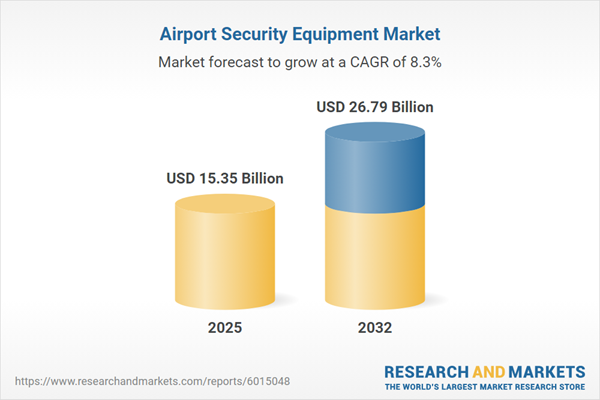Speak directly to the analyst to clarify any post sales queries you may have.
Airports globally are turning to advanced security equipment as both passenger safety and operational efficiency demand robust, scalable solutions. In an environment shaped by evolving threats and regulatory scrutiny, the airport security equipment market is undergoing significant transformation, impacting procurement, deployment, and innovation strategies for leaders across aviation infrastructure.
Market Snapshot: Airport Security Equipment Market
The airport security equipment market grew from USD 14.18 billion in 2024 to USD 15.35 billion in 2025. It is expected to continue expanding at a CAGR of 8.27%, reaching USD 26.79 billion by 2032. This positive trajectory reflects investments in next-generation solutions as airports respond to increased travel volume and rising expectations for both passenger experience and regulatory compliance. Technology convergence and digital transformation are key drivers reshaping how airports safeguard people and assets while maintaining throughput and convenience.
Scope & Segmentation
This analysis covers the full landscape of airport security equipment, structured to empower strategic decision-making:
- Equipment Types: Access control systems, baggage handling systems, biometric systems, explosive trace detection systems, metal detectors, X-ray inspection systems (including computed tomography, dual and multi-energy CT, dual view, multi view, and single view X-ray).
- Technologies: 3D imaging, computed tomography, millimeter wave scanning, AI-based solutions, deep learning algorithms, machine learning algorithms, analog imaging, digital imaging.
- Applications: Baggage screening, hold baggage scanning, in-line baggage scanning, cargo screening, passenger screening, body scanning, carry-on screening, vehicle inspection.
- End Users: Airline operators, airport authorities, government agencies (border patrol, customs, homeland security), third-party security providers.
- Distribution Channels: Aftermarket services (maintenance, upgrades), direct sales, independent and OEM distributors, e-commerce marketplaces, manufacturer websites.
- Geographies: Americas (United States, Canada, Mexico, Brazil, Argentina, Chile, Colombia, Peru), Europe, Middle East and Africa (including United Kingdom, Germany, France, Russia, Italy, Spain, Netherlands, Sweden, Poland, Switzerland, UAE, Saudi Arabia, Qatar, Turkey, Israel, South Africa, Nigeria, Egypt, Kenya), and Asia-Pacific (China, India, Japan, Australia, South Korea, Indonesia, Thailand, Malaysia, Singapore, Taiwan).
- Market Players: Analysis includes Smiths Detection Ltd, L3Harris Technologies, Inc., OSI Systems, Inc., Nuctech Company Limited, Leidos Holdings, Inc., Thales S.A., Rohde & Schwarz GmbH & Co. KG, Honeywell International Inc., CEIA S.p.A., Garrett Metal Detectors, Inc.
Key Takeaways for Senior Decision-Makers
- Rapid innovation in airport security equipment is enabling scalable upgrades, allowing airports to adapt to changing threat landscapes and evolving compliance requirements.
- Strategic integration of AI and biometric technologies is improving accuracy in screening while supporting seamless passenger movement through checkpoints.
- Vendor collaborations and alliances with research institutions are generating proprietary solutions, fostering competitive differentiation within the airport security equipment market.
- Localized assembly initiatives and supply diversification are reducing risk exposure to global trade disruptions and fluctuating material costs.
- There is an increasing shift from analog systems to digital, supporting remote diagnostics, real-time monitoring, and predictive maintenance to maximize uptime and asset longevity.
- Regional approaches to procurement prioritize flexibility and alignment with local and international standards, impacting vendor strategies and technology roadmaps.
Tariff Impact & Supply Chain Adaptation
Recent tariff policies in key markets have heightened the cost of core components such as metals and electronics, disrupting global supply chains. In response, industry leaders are renegotiating supplier contracts, shifting production hubs, and exploring alternative materials to manage cost structures and ensure reliable deliveries. Such operational agility is crucial to sustaining competitiveness amidst policy uncertainties.
Methodology & Data Sources
This report blends primary research, including executive interviews and stakeholder surveys, with robust secondary analysis of technical publications, patents, regulatory documents, and market data. Validation was achieved through expert panels and scenario-based quantitative modeling, aligning qualitative insight with real-world trends in the airport security equipment market.
Why This Report Matters
- Identifies actionable opportunities and emerging risks across the airport security equipment ecosystem, guiding investment and procurement decisions for operational optimization.
- Enables benchmarking of regional trends, technology adoption, and supplier strategies tailored to strategic growth, risk mitigation, and compliance objectives.
- Supports long-term planning with recommendations addressing flexibility, resilience, and partnership development in line with evolving industry requirements.
Conclusion
Senior stakeholders will benefit from a comprehensive view of emerging technologies, supply chain dynamics, and collaborative strategies shaping the airport security equipment market. Strategic foresight and agile execution are critical to capitalizing on opportunities as the sector continues to evolve.
Additional Product Information:
- Purchase of this report includes 1 year online access with quarterly updates.
- This report can be updated on request. Please contact our Customer Experience team using the Ask a Question widget on our website.
Table of Contents
3. Executive Summary
4. Market Overview
7. Cumulative Impact of Artificial Intelligence 2025
Companies Mentioned
The companies profiled in this Airport Security Equipment market report include:- Smiths Detection Ltd
- L3Harris Technologies, Inc.
- OSI Systems, Inc.
- Nuctech Company Limited
- Leidos Holdings, Inc.
- Thales S.A.
- Rohde & Schwarz GmbH & Co. KG
- Honeywell International Inc.
- CEIA S.p.A.
- Garrett Metal Detectors, Inc.
Table Information
| Report Attribute | Details |
|---|---|
| No. of Pages | 187 |
| Published | October 2025 |
| Forecast Period | 2025 - 2032 |
| Estimated Market Value ( USD | $ 15.35 Billion |
| Forecasted Market Value ( USD | $ 26.79 Billion |
| Compound Annual Growth Rate | 8.2% |
| Regions Covered | Global |
| No. of Companies Mentioned | 11 |









